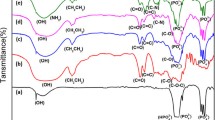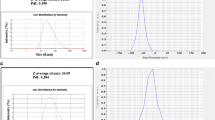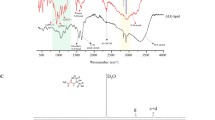Abstract
Purpose
Nanoparticles with prolonged residence time in bone constitute a valuable strategy for bone disease treatments. The aim of this work was to synthesise a simple nanoparticulate system exhibiting both anticancer and hydroxyapatite binding properties for potential bone cancer applications.
Methods
The amphiphilic copolymer poly(γ-benzyl-glutamate)-block-poly(glutamic acid) (PBLG-b-PGlu) was synthetised by ring opening polymerization and nanoparticles were obtained by a simple nanoprecipitation method. Nanoparticles were characterized in terms of cisplatin interaction, association, and release as well as interaction with hydroxyapatite and their cytoxicity was studied in three prostate cancer cell lines.
Results
PBLG-b-PGlu nanoparticles of ~50 nm in size were successfully prepared. They could display for the first time dual hydroxyapatite binding and anticancer properties mediated by the PGlu moiety. They could complex cisplatin at a drug loading content of 6.2% (w/w). Cisplatin release was triggered by physiological concentrations of chloride ions according to an almost zero order kinetics during 14 days. Simultaneously, these nanoparticles showed in vitro hydroxyapatite binding. Finally, they were shown to exert a cytotoxic effect in three prostate cancer cell lines that potentially metastasize to bone.
Conclusions
These properties suggest the potential utility of cisplatin-loaded PBLG-b-PGlu nanoparticles as carrier systems for the treatment of bone metastases.






Similar content being viewed by others
Abbreviations
- AAS:
-
Atomic absorption spectroscopy
- BLG-NCA:
-
γ-benzyl-L-glutamate-N-carboxylic anhydride
- CDCl3 :
-
Deuterated chloroform
- CDDP:
-
Cisplatin
- DLS:
-
Dynamic light scattering
- DMF:
-
Dimethylformamide
- DPn :
-
Degree of polymerization
- FTIR:
-
Fourier transform infrared spectroscopy
- H NMR:
-
Proton nuclear magnetic resonance
- HAP:
-
Hydroxyapatite
- ITC:
-
Isothermal titration calorimetry
- MTS:
-
([3-(4,5-dimethylthiazol-2-yl)-5-(3-carboxymethoxyphenyl)-2-(4 sulfophenyl)-2H tetrazolium, inner salt)
- PBLG-b-PGlu:
-
Poly(γ-benzyl-glutamate)-block-poly(glutamic acid)
- PBS:
-
Phosphate buffer saline
- ROP:
-
Ring opening polymerization
- SEC:
-
Size exclusion chromatography
- TEM:
-
Transmission Electron Microscopy
- TFA:
-
Trifluoroacetic acid
REFERENCES
Siegel R, Naishadham D, Jemal A. Cancer statistics. CA Cancer J Clin. 2012;62(1):10–29.
Coleman RE. Metastatic bone disease: clinical features, pathophysiology and treatment strategies. Cancer Treat Rev. 2001;27(3):165–76.
Hirabayashi H, Fujisaki J. Bone-specific drug delivery systems: approaches via chemical modification of bone-seeking agents. Clin Pharmacokinet. 2003;42(15):1319–30.
Low SA, Kopeček J. Targeting polymer therapeutics to bone. Adv Drug Deliv Rev. 2012;64(12):1189–204.
Fujisaki J, Tokunaga Y, Takahashi T, Kimura S, Shimojo F, Hata T. Osteotropic drug delivery system (ODDS) based on bisphosphonic prodrug. V. Biological disposition and targeting characteristics of osteotropic estradiol. Biol Pharm Bull. 1997;20(11):1183–7.
Sekido T, Sakura N, Higashi Y, Miya K, Nitta Y, Nomura M, et al. Novel drug delivery system to bone using acidic oligopeptide: pharmacokinetic characteristics and pharmacological potential. J Drug Target. 2001;9(2):111–21.
Kasugai S, Fujisawa R, Waki Y, Miyamoto K, Ohya K. Selective drug delivery system to bone: small peptide (Asp)6 conjugation. J Bone Miner Res. 2000;15(5):936–43.
Ye H, Jin L, Hu R, Yi Z, Li J, Wu Y, et al. Poly(gamma-L-glutamic acid) cisplatin conjugate effectively inhibits human breast tumor xenografted in nude mice. Biomaterials. 2006;27(35):5958–65.
Pinzani V, Bressolle F, Johanne Haug I, Galtier M, Blayac JP, Balmès P. Cisplatin-induced renal toxicity and toxicity-modulating strategies: a review. Cancer Chemother Pharmacol. 1994;35(1):1–9.
Harmers FP, Gispen WH, Neijt JP. Neurotoxic side-effects of cisplatin. Eur J Cancer. 1991;27(3):372–6.
Galanski M, Keppler BK. Searching for the magic bullet: anticancer platinum drugs which can be accumulated or activated in the tumor tissue. Anticancer Agents Med Chem. 2007;7(1):55–73.
Yonou H, Yokose T, Kamijo T, Kanomata N, Hasebe T, Nagai K, et al. Establishment of a novel species- and tissue-specific metastasis model of human prostate cancer in humanized non-obese diabetic/severe combined immunodeficient mice engrafted with human adult lung and bone. Cancer Res. 2001;61(5):2177–82.
Higashi N, Koga T, Niwa M. Helical superstructures from a poly(γ-benzyl-l-glutamate)−poly(l-glutamic acid) amphiphilic diblock copolymer: monolayer formation on water and its specific binding of amino acids. Langmuir. 2000;16(7):3482–6.
Crespo JS, Lecommandoux S, Borsali R, Klok HA, Soldi V. Small-angle neutron scattering from diblock copolymer poly(styrene-d8)-b-poly(γ-benzyl l-glutamate) solutions: rod−coil to coil−coil transition. Macromolecules. 2003;36(4):1253–6.
Feng Z, Lai Y, Ye H, Huang J, Xi XG, Wu Z. Poly (gamma- L-glutamic acid)-cisplatin bioconjugate exhibits potent antitumor activity with low toxicity: a comparative study with clinically used platinum derivatives. Cancer Sci. 2010;101(11):2476–82.
Zhu W, Li Y, Liu L, Zhang W, Chen Y, Xi F. Biamphiphilic triblock copolymer micelles as a multifunctional platform for anticancer drug delivery. J Biomed Mater Res A. 2010;96A(2):330–40.
Papadopoulos P, Floudas G, Klok HA, Schnell I, Pakula T. Self-assembly and dynamics of poly(gamma-benzyl-l-glutamate) peptides. Biomacromolecules. 2004;5(1):81–91.
Rinaudo M, Domard A. Circular dichroism studies on alpha-L-glutamic acid oligomers in solution. J Am Chem Soc. 1976;98(20):6360–4.
Barbosa MEM, Montembault V, Cammas-Marion S, Ponchel G, Fontaine L. Synthesis and characterization of novel poly(γ-benzyl-L-glutamate) derivatives tailored for the preparation of nanoparticles of pharmaceutical interest. Polym Int. 2007;56(3):317–24.
Segura-Sanchez F, Montembault V, Fontaine L, Martinez-Barbosa ME, Bouchemal K, Ponchel G. Synthesis and characterization of functionalized poly(gamma-benzyl-L-glutamate) derivates and corresponding nanoparticles preparation and characterization. Int J Pharm. 2010;387(1–2):244–52.
Buffeteau T, Le Calvez E, Castano S, Desbat B, Blaudez D, Dufourcq J. Anisotropic optical constants of α-helix and β-sheet secondary structures in the infrared. J Phys Chem B. 2000;104(18):4537–44.
Nishiyama N, Yokoyama M, Aoyagi T, Okano T, Sakurai Y, Kataoka K. Preparation and characterization of self-assembled polymer metal complex micelle from cis-dichlorodiammineplatinum(II) and poly(ethylene glycol)-poly(L-aspartic acid) block copolymer in an aqueous medium. Langmuir. 1999;15(2):377–83.
Chou PY, Scheraga HA. Calorimetric measurement of enthalpy change in the isothermal helix–coil transition of poly-L-lysine in aqueous solution. Biopolymers. 1971;10(4):657–80.
Nishiyama N, Kataoka K. Preparation and characterization of size-controlled polymeric micelle containing cis-dichlorodiammineplatinum(II) in the core. J Control Release. 2001;74(1–3):83–94.
Xia Y, Wang Y, Wang Y, Tu C, Qiu F, Zhu L, et al. A tumor pH-responsive complex: Carboxyl-modified hyperbranched polyether and cis-dichlorodiammineplatinum(II). Colloids Surf B: Biointerfaces. 2011;88(2):674–81.
Krizkova S, Adam V, Petrlova J, Zitka O, Stejskal K, Zehnalek J, et al. A suggestion of electrochemical biosensor for study of platinum(II)-DNA interactions. Electroanalysis. 2007;19(2–3):331–8.
Nilsson S, Zhang W. Helix-coil transition of a titrating polyelectrolyte analyzed within the Poisson-Boltzmann cell model: effects of pH and salt concentration. Macromolecules. 1990;23(25):5234–9.
Olander DS, Holtzer A. Stability of the polyglutamic acid alpha helix. J Am Chem Soc. 1968;90(17):4549–60.
Holtzer A, Hawkins RB. The state of aggregation of α-helical poly(l-glutamic acid) in aqueous salt solutions. J Am Chem Soc. 1996;118(17):4220–1.
Kimura T, Takahashi S, Akiyama S, Uzawa T, Ishimori K, Morishima I. Direct observation of the multistep helix formation of poly-l-glutamic acids. J Am Chem Soc. 2002;124(39):11596–7.
Gianasi E, Wasil M, Evagorou EG, Keddle A, Wilson G, Duncan R. HPMA copolymer platinates as novel antitumour agents: in vitro properties, pharmacokinetics and antitumour activity in vivo. Eur J Cancer. 1999;35(6):994–1002.
de Miguel L, Noiray M, Surpateanu G, Iorga BI, Ponchel G. Poly(γ-benzyl-L-glutamate)-PEG-alendronate multivalent nanoparticles for bone targeting. Int J Pharm. 2014;460(1–2):73–82.
Ishizaki J, Waki Y, Takahashi-Nishioka T, Yokogawa K, Miyamoto K-I. Selective drug delivery to bone using acidic oligopeptides. J Bone Miner Metab. 2009;27(1):1–8.
Barroug A, Glimcher MJ. Hydroxyapatite crystals as a local delivery system for cisplatin: adsorption and release of cisplatin in vitro. J Orthop Res. 2002;20(2):274–80.
ACKNOWLEDGMENTS AND DISCLOSURES
We gratefully acknowledge the European postgraduate program from “Ibercaja Foundation” for the financial support of Laura de Miguel. This work has benefited from the facilities and expertise of the Platform for Transmission Electronic Microscopy of IMAGIF (Centre de Recherche de Gif - www.imagif.cnrs.fr) and we thank Miss Cynthia Gillet for her valuable help with the TEM image acquisitions. We thank Dr Silvia Mazzaferro and LCPO, Univ. Bordeaux, CNRS, UMR 5629 for the SEC analyses.
Author information
Authors and Affiliations
Corresponding author
Electronic supplementary material
Below is the link to the electronic supplementary material.
ESM 1
(DOCX 25.7 Mb)
Rights and permissions
About this article
Cite this article
de Miguel, L., Popa, I., Noiray, M. et al. Osteotropic Polypeptide Nanoparticles with Dual hydroxyapatite Binding Properties and Controlled Cisplatin Delivery. Pharm Res 32, 1794–1803 (2015). https://doi.org/10.1007/s11095-014-1576-z
Received:
Accepted:
Published:
Issue Date:
DOI: https://doi.org/10.1007/s11095-014-1576-z




